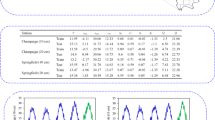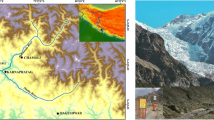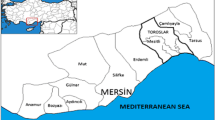Abstract
The aim of this study is to estimate the soil temperatures of a target station using only the soil temperatures of neighboring stations without any consideration of the other variables or parameters related to soil properties. For this aim, the soil temperatures were measured at depths of 5, 10, 20, 50, and 100 cm below the earth surface at eight measuring stations in Turkey. Firstly, the multiple nonlinear regression analysis was performed with the “Enter” method to determine the relationship between the values of target station and neighboring stations. Then, the stepwise regression analysis was applied to determine the best independent variables. Finally, an artificial neural network (ANN) model was developed to estimate the soil temperature of a target station. According to the derived results for the training data set, the mean absolute percentage error and correlation coefficient ranged from 1.45% to 3.11% and from 0.9979 to 0.9986, respectively, while corresponding ranges of 1.685–3.65% and 0.9988–0.9991, respectively, were obtained based on the testing data set. The obtained results show that the developed ANN model provides a simple and accurate prediction to determine the soil temperature. In addition, the missing data at the target station could be determined within a high degree of accuracy.







Similar content being viewed by others
References
Bilgili, M. (2009). Estimation of net electricity consumption of Turkey. Journal of Thermal Science and Technology, 29, 89–98.
Bilgili, M. (2010). Prediction of soil temperature using regression and artificial neural network models. Meteorology and Atmospheric Physics, 110, 59–70.
Bilgili, M., & Sahin, B. (2010). Comparative analysis of regression and artificial neural network models for wind speed prediction. Meteorology and Atmospheric Physics, 109, 61–72.
Bilgili, M., Sahin, B., & Simsek, E. (2010). Wind energy density in the southern, southwestern and western region of Turkey. Journal of Thermal Science and Technology, 30, 1–12.
Cankaya, S. (2009). A comparative study of some estimation methods for parameters and effects of outliers in simple regression model for research on small ruminants. Tropical Animal Health and Production, 41, 35–41.
Cevik, A. (2007). Unified formulation for web crippling strength of cold-formed steel sheeting using stepwise regression. Journal of Constructional Steel Research, 63, 1305–1316.
Coppi, R., D’Urso, P., Giordani, P., & Santoro, A. (2006). Least squares estimation of a linear regression model with LR fuzzy response. Computational Statistics and Data Analysis, 51, 267–286.
Droulia, F., Lykoudis, S., Tsiros, I., Alvertos, N., Akylas, E., & Garofalakis, I. (2009). Ground temperature estimations using simplified analytical and semi-empirical approaches. Solar Energy, 83, 211–219.
Elminir, H. K., Azzam, Y. A., & Younes, F. I. (2007). Prediction of hourly and daily diffuse fraction using neural network, as compared to linear regression models. Energy, 32, 1513–1523.
Enrique, G., Braud, I., Jean-Louis, T., Michel, V., Pierre, B., & Jean-Christophe, C. (1999). Modelling heat and water exchanges of fallow land covered with plant-residue mulch. Agricultural and Forest Meteorology, 97, 151–169.
Fan, A. W., & Liu, W. (2003). Simulation of the daily change of soil temperature under different conditions. Heat Transfer-Asian Research, 32, 533–544.
Gao, Z., Bian, L., Hu, Y., Wang, L., & Fan, J. (2007). Determination of soil temperature in an arid region. Journal of Arid Environments, 71, 157–168.
Gao, Z., Horton, R., Wang, L., Liu, H., & Wen, J. (2008). An improved force-restore method for soil temperature prediction. European Journal of Soil Science, 59, 972–981.
García-Suárez, A. M., & Butler, C. J. (2006). Soil temperatures at Armagh observatory, northern Ireland, from 1904 to 2002. International Journal of Climatology, 26, 1075–1089.
Gencoglu, M. T., & Cebeci, M. (2009). Investigation of pollution flashover on high voltage insulators using artificial neural network. Expert Systems with Applications, 36, 7338–7345.
George, R. K. (2001). Prediction of soil temperature by using artificial neural networks algorithms. Nonlinear Analysis, 47, 1737–1748.
Haykin, S. (1994). Neural networks, a comprehensive foundation. New Jersey: Prentice-Hall, Inc.
Kalogirou, S. A. (2001). Artificial neural networks in renewable energy systems applications: a review. Renewable and Sustainable Energy Reviews, 5, 373–401.
Kang, S., Kim, S., Oh, S., & Lee, D. (2000). Predicting spatial and temporal patterns of soil temperature based on topography, surface cover and air temperature. Forest Ecology and Management, 136, 173–184.
Kätterer, T., & Andrén, O. (2009). Predicting daily soil temperature profiles in arable soils in cold temperate regions from air temperature and leaf area index. Acta Agriculturae Scandinavica, Section B-Plant Soil Science, 59, 77–86.
Kisi, O. (2004). River flow modeling using artificial neural networks. Journal of Hydrologic Engineering, 9, 60–63.
Koçak, K., Şaylan, L., & Eitzinger, J. (2004). Nonlinear prediction of near-surface temperature via univariate and multivariate time series embedding. Ecological Modelling, 173, 1–7.
Kok, B. V., Yilmaz, M., Sengoz, B., Sengur, A., & Avci, E. (2010). Investigation of complex modulus of base and SBS modified bitumen with artificial neural networks. Expert Systems with Applications, 37, 7775–7780.
Kostopoulou, E., Giannakopoulos, C., Anagnostopoulou, C., Tolika, K., Maheras, P., Vafiadis, M., et al. (2007). Simulating maximum and minimum temperature over Greece: a comparison of three downscaling techniques. Theoretical and Applied Climatology, 90, 65–82.
Lisi, F., & Schiavo, R. A. (1999). A comparison between neural networks and chaotic models for exchange rate prediction. Computational Statistics and Data Analysis, 30, 87–102.
Mendes, D., & Marengo, J. A. (2010). Temporal downscaling: A comparison between artificial neural network and autocorrelation techniques over the Amazon Basin in present and future climate change scenarios. Theoretical and Applied Climatology, 100, 413–421.
Mihalakakou, G. (2002). On estimating soil surface temperature profiles. Energy and Buildings, 34, 251–259.
Özbayoğlu, G., & Özbayoğlu, M. E. (2006). A new approach for the prediction of ash fusion temperatures: A case study using Turkish lignites. Fuel, 85, 545–552.
Paul, K. I., Polglase, P. J., Smethurst, P. J., O’Connell, A. M., Carlyle, C. J., & Khanna, P. K. (2004). Soil temperature under forests: A simple model for predicting soil temperature under a range of forest types. Agricultural and Forest Meteorology, 121, 167–182.
Prangnell, J., & McGowan, G. (2009). Soil temperature calculation for burial site analysis. Forensic Science International, 191, 104–109.
Rahimikhoob, A. (2009). Estimating daily pan evaporation using artificial neural network in a semi-arid environment. Theoretical and Applied Climatology, 98, 101–105.
Rahimikhoob, A. (2010). Estimation of evapotranspiration based on only air temperature data using artificial neural networks for a subtropical climate in Iran. Theoretical and Applied Climatology, 101, 83–91.
Sangun, L., Cankaya, S., Kayaalp, G. T., & Akar, M. (2009). Use of factor analysis scores in multiple regression model for estimation of body weight from some body measurements in lizardfish. Journal of Animal and Veterinary Advances, 8, 47–50.
Şenkal, O., Yıldız, B. Y., Şahin, M., & Pestemalcı, V. (2011). Precipitable water modelling using artificial neural network in Çukurova region. Environmental Monitoring and Assessment. doi:10.1007/s10661-011-1953-6.
Sözen, A., Arcaklioğlu, E., Özalp, M., & Kanit, E. G. (2005). Solar energy potential in Turkey. Applied Energy, 80, 367–381.
Tenge, A. J., Kagihura, F. B. S., Lal, R., & Singh, B. R. (1998). Diurnal soil temperature fluctuations for different erosion classes of an oxisol at Mlingano, Tanzania. Soil and Tillage Research, 49, 211–217.
Tian, J., Juhola, M., & Gröfors, T. (1997). AR parameter estimation by a feedback neural network. Computational Statistics and Data Analysis, 25, 17–24.
Ustaoglu, B., Cigizoglu, H. K., & Karaca, M. (2008). Forecast of daily mean, maximum and minimum temperature time series by three artificial neural network methods. Meteorological Applications, 15, 431–445.
Walter, A., & Schönwiese, C. D. (2003). Nonlinear statistical attribution and detection of anthropogenic climate change using a simulated annealing algorithm. Theoretical and Applied Climatology, 76, 1–12.
Yılmaz, T., Özbek, A., Yılmaz, A., & Büyükalaca, O. (2009). Influence of upper layer properties on the ground temperature distribution. Journal of Thermal Science and Technology, 29, 43–51.
Acknowledgments
The authors would like to express their appreciation to the Turkish State Meteorological Services for providing the data.
Author information
Authors and Affiliations
Corresponding author
Rights and permissions
About this article
Cite this article
Bilgili, M., Sahin, B. & Sangun, L. Estimating soil temperature using neighboring station data via multi-nonlinear regression and artificial neural network models. Environ Monit Assess 185, 347–358 (2013). https://doi.org/10.1007/s10661-012-2557-5
Received:
Accepted:
Published:
Issue Date:
DOI: https://doi.org/10.1007/s10661-012-2557-5




